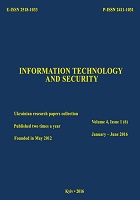Consequences of possible cyberattacks on objects of the critical infrastructure
DOI:
https://doi.org/10.20535/2411-1031.2016.4.1.96101Keywords:
Cyberthreat, cyberattack, critical infrastructure, consequences, automatic control system, process industries.Abstract
Vital government areas for critical infrastructures defined by availability of automatic control systems of process industries. They include supervisory control and data acquisition systems, distributed control system. In this basis research of negative consequences possible cyberattacks on objects of a critical infrastructure is executed. The basic categories of influence of destructive actions in the automated systems by technological processes on objects of a critical infrastructure are resulted. The concept of object of a critical infrastructure reveals. The interrelation between cyberattacks on object of a critical infrastructure and consequences in industrial sector is shown. Criteria on which the list of information-telecommunication systems of objects of a critical infrastructure of the state is formed are resulted. Actives of objects of a critical infrastructure and a damage which can be caused them are considered. The statistics of incidents on objects of a critical infrastructure on branches for previous year is resulted. The diagram is resulted, where it is shown, that the greatest quantity of incidents is necessary on manufacture and power branch. The concept of a direct and indirect damage to information system of objects of a critical infrastructure reveals.It is shown, that recently in the world cyberattacks are directed on computer networks of power sector, a diplomatic corps, power departments, a defensive complex, the state enterprises, media of the companies. It is shown, that the purpose such cyberattacks, first of all, drawing of a damage to a critical infrastructure of the state. Results of the carried out research can be used at an urgency estimation cyberthreats objects of a critical infrastructure.
References
Cabinet of Ministers of Ukraine. (2016, Aug. 23). Resolution number 563, Approval the order of formation of the list of information and telecommunication systems акщь from the objects of critical infrastructure of the government [Online]. Available: http://zakon.rada.gov.ua/laws/ show/563-2016-%D0%BF. Accessed on: Dec. 18, 2015.
S.F. Honchar, “Features of cybersecurity industrial control systems”, in Proc. International Scientific Conference Problems and prospects of power engineering, electrotechnology and automation in agriculture, Kyiv, Ukraine, 2013, pp. 36-37.
ICS-CERT Monitor 2015. [Online]. Available: http://ics-cert.us-cert.gov/monitors. Accessed on: Dec. 18, 2015.
V.V. Domarev, Safety of information technologies. Methodology of creation of systems of protection. Kyiv, Ukraine: ООО “TYD “DS”, 2002.
Council of the European Union. (2008, Dec. 08). Directive 2008/114/EC, On the identification and designation of European critical infrastructures and the assessment of the need to improve their protection. [Online]. Available: http://eur-lex.europa.eu/legal-content/EN/ALL/?uri= celex:32008L0114. Accessed on: Dec. 18, 2015.
Downloads
Published
How to Cite
Issue
Section
License
Copyright (c) 2020 Collection "Information technology and security"

This work is licensed under a Creative Commons Attribution 4.0 International License.
The authors that are published in this collection, agree to the following terms:
- The authors reserve the right to authorship of their work and pass the collection right of first publication this work is licensed under the Creative Commons Attribution License, which allows others to freely distribute the published work with the obligatory reference to the authors of the original work and the first publication of the work in this collection.
- The authors have the right to conclude an agreement on exclusive distribution of the work in the form in which it was published this anthology (for example, to place the work in a digital repository institution or to publish in the structure of the monograph), provided that references to the first publication of the work in this collection.
- Policy of the journal allows and encourages the placement of authors on the Internet (for example, in storage facilities or on personal web sites) the manuscript of the work, prior to the submission of the manuscript to the editor, and during its editorial processing, as it contributes to productive scientific discussion and positive effect on the efficiency and dynamics of citations of published work (see The Effect of Open Access).

